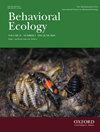Timing of egg-laying in relation to a female’s social environment in European starlings
IF 2.2
3区 环境科学与生态学
Q2 BEHAVIORAL SCIENCES
引用次数: 0
Abstract
It is widely assumed that female birds use non-photic supplemental cues, including social factors, to fine-tune timing of egg-laying to local conditions, but our knowledge of the nature of these social cues and how they operate remains limited. We analyzed the relationship between a female’s social environment (nearest neighbor distances, residency, female -and- network familiarity, synchrony) and variation in timing of egg-laying in European starlings (Sturnus vulgaris) using individual, residual laying date (controlling for annual variation) and temperature-independent residual laying date (accounting for the effect of ambient temperature on laying date). Female social environment varied systematically with overall spatial distribution of nest-boxes (linear vs clumped boxes) but this was not associated with spatial variation in laying date or temperature-independent residual laying date. We found no evidence for any relationships between individual variation in social environment and individual, residual laying date and only weak evidence for any association with individual, temperature-independent residual laying date. The latter was associated with a) nearest neighbor distances in the linear habitat, with females nesting closer to neighbors laying earlier than predicted by temperature, but not in the two clumped habitats, and b) neighbor familiarity: females with an intermediate number of returning females (3/8) laid closest to the predicted date. Finally, despite the fact that synchrony was not associated with other social environment metrics, females with lower laying synchrony among neighbors laid earlier than predicted by temperature. This suggests that some components of the female-female social environment could act as supplemental cues for timing of egg-laying.欧洲椋鸟产卵时间与雌鸟社会环境的关系
人们普遍认为,雌鸟会利用包括社会因素在内的非雌性补充线索来根据当地条件对产卵时间进行微调,但我们对这些社会线索的性质及其运作方式的了解仍然有限。我们利用欧洲椋鸟(Sturnus vulgaris)的个体、残余产卵日期(控制年度变化)和与温度无关的残余产卵日期(考虑环境温度对产卵日期的影响),分析了雌鸟的社会环境(近邻距离、居住地、雌鸟与网络的熟悉程度、同步性)与产卵时间变化之间的关系。雌鸟的社会环境随巢箱的总体空间分布(线性巢箱与丛状巢箱)而系统地变化,但这与产卵日期或与温度无关的剩余产卵日期的空间变化无关。我们没有发现任何证据表明社会环境的个体差异与个体剩余产卵期之间存在任何关系,只有微弱的证据表明与个体温度无关的剩余产卵期存在任何关系。后者与以下因素有关:a)线性栖息地中的近邻距离,靠近邻居的雌性产卵早于温度预测的时间,但在两个集群栖息地中则不然;b)邻居的熟悉程度:返回雌性数量处于中间水平(3/8)的雌性产卵最接近预测的时间。最后,尽管同步性与其他社会环境指标无关,但邻居间产卵同步性较低的雌性的产卵期早于温度预测的产卵期。这表明,雌-雌社会环境的某些成分可以作为产卵时间的补充线索。
本文章由计算机程序翻译,如有差异,请以英文原文为准。
求助全文
约1分钟内获得全文
求助全文
来源期刊

Behavioral Ecology
环境科学-动物学
CiteScore
5.20
自引率
8.30%
发文量
93
审稿时长
3.0 months
期刊介绍:
Studies on the whole range of behaving organisms, including plants, invertebrates, vertebrates, and humans, are included.
Behavioral Ecology construes the field in its broadest sense to include 1) the use of ecological and evolutionary processes to explain the occurrence and adaptive significance of behavior patterns; 2) the use of behavioral processes to predict ecological patterns, and 3) empirical, comparative analyses relating behavior to the environment in which it occurs.
 求助内容:
求助内容: 应助结果提醒方式:
应助结果提醒方式:


